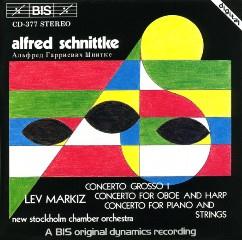Alfred Schnittke – Concerto Grosso No.1· Concerto For Oboe And Harp· Concerto For Piano And Strings (1987)
Alfred Schnittke – Concerto Grosso No.1· Concerto For Oboe And Harp· Concerto For Piano And Strings (1987)

Concerto Grosso I Für 2 Violinen, Cembalo, Präp. Klavier Und Streicher (1977) 1 Preludio 5:59 2 Toccata 4:44 3 Recitavo 8:50 4 Cadenza 2:30 5 Rondo 7:30 6 Postludio 2:36 7 Konzert Für Oboe, Harfe Und Streichorchester (1971) 17:09 8 Konzert Für Klavier Und Streichorchester (1979) 20:30 Kjell Axel Lier - harp (7) Helén Jahren - oboe (7) Roland Pöntinen - piano (1-6, 8) New Stockholm Chamber Orchestra Lev Markiz - conductor
If Alfred Schnittke is a "poster child" of musical postmodernism, his Concerto Grosso No. 1 (1977) is his poster work. One of the few orchestral works written after 1945 to enter the repertoire of ensembles worldwide, its uneasy fusion of old and new, high and low, and grave and comical captures what is most Schnittkean about Schnittke. This is no mean feat: the "Schnittkean" is a quality so conflicted, so nomadic and self-deconstructing, that it is almost illusory; the second one catches up to it, it's just fallen through a trap door. Likewise, Concerto Grosso No. 1 is a high-velocity funhouse of masks. Their unveiling is uproarious and caustically black, their liveliness optimistic, but their trajectory doomed.
This unveiling is also Schnittke's central compositional strategy, something he calls "polystylism." More than mere eclecticism, "polystylism" is for Schnittke a musical last resort for building large works; it is a means for dynamic musical theater, whether comedy or tragedy; it is also, as Schnittke believes, the best way of creating successful musical tension amidst unprecedented musical freedom. And so polystylism is eclectic, but never indifferent; it always intends to confront, surprise, and subvert with utmost calculation. Hence the Schnittkean paradox: things stick together by falling apart, in exactly the right places, at exactly the right times. ---Seth Brodsky, allmusic.com
Commissioned by the great duo of Heinz and Ursula Holliger, Concerto For Oboe And Harp is a memorial for two of Schnittke's close friends. And it is this basic lament-process that entirely overtakes the piece from its first notes to its last; indeed, so unyielding is the work's progression that it suggests the archaic rituals of formal tragedy, a literal tragoedia or "goat-song" with the oboe and harp serving as a modern-day aulos and kithara, sounding a sorrow which must dig back to antiquity for its just shape.
In serving this lament, however, Schnittke constructs a rather brilliant harmonic and gestural edifice. Though the melodic and intervalic writing in general feels extremely free and atonal, much of the actual pitch-logic of piece stems from a "row" of chromatically descending tones; this chromatic descending motif has been a standard gesture of lament since the early-Baroque period. However, the descending motif remains somewhat subliminal, since Schnittke constantly transposes the pitches to create extremely wide, expressionistically gestural lines. The effect is not unlike a small boat sinking in a storm: its submergence is paradoxically counterbalanced by the sheer violence with which the passengers panic, and the turbulence with which the waves crash. Here perhaps another writer close to Schnittke's heart deserves mention: Dostoyevsky's notion of the "non-Euclidean" (articulated through Ivan Karamazov) seems quite apt here, in this music in which every direction, even the most upward-leaping, ultimately points downwards.
The form, somewhat rare in Schnittke's later work, is a single arch-form, which expands and contracts like a sorrowful monodic breath. After a slowly unfolding introduction, the tone changes when the oboe begins to re-direct the ensemble upward; proximitous falls begin to alternate with sudden spins upward, and a kind of elastic, hyper-expressive vortex ensues. The harp begins to strum thick, scrim-like chords as the oboe skips and stutters, and eventually the discourse begins to break down, fulminating in a scream-like climax and breathless coda. In truth, the only the work itself "points downwards"; like Kafka's work, however, its vision (even as it plummets) never lets the heavens out of its sight. ---Seth Brodsky, allmusic.com
Alfred Schnittke wrote his Concerto for Piano and String Orchestra in one extended movement. It begins with a long, slow introduction from the piano. When the strings enter, the piano joins them to play various fragments of melody. These fragments are repeated and elaborated upon, and then seem to drop out of sight. This portion of the work includes a passage that resembles a Russian Orthodox hymn and a passage reminiscent of Prokofiev. The work comes to a quasi-climax, but immediately after the massed fortissimo there follows only silence. After this false climax, the piano has a cadenza reminiscent of the introduction, but which also includes echoes of the earlier music. The music moves to a frenzied climax again, and this time the climax is a true one. After it ends, however, the music becomes slower and bleaker. This section features a lamenting string quartet with occasional virtuoso figurations from the piano. The work ends in an ambiguous mood, reminiscent of what has come before, but also suggestive that there is hope for what comes after. Schnittke's piano writing is idiomatic and virtuosic, and much of the writing for the strings has a tonal character, making the Concerto for Piano and String Orchestra one of Schnittke's more accessible works. It is recommended for anyone wanting an introduction to this unique composer. ---Andrew Lindemann Malone, allmusic.com
download (mp3 @320 kbs):








